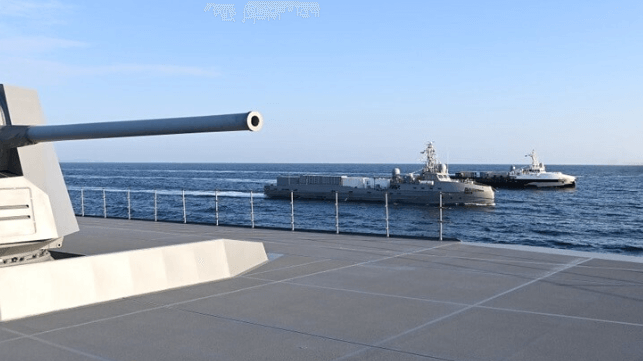Calling All Crewboats: U.S. Navy Seeks Midsize Hulls for Unmanned Program

The U.S. military has been experimenting with midsize unmanned vessels for years, testing them out on extended ocean voyages and in fleet exercises. But tech evangelists say that the U.S. Navy has been moving too slowly to acquire and use these platforms at scale - especially given the snowballing problems in its conventional shipbuilding pipeline. That may be about to change: Naval Sea Systems Command's unmanned office has asked industry for ways to deliver a long-awaited Medium Unmanned Surface Vehicle (MUSV) within the span of a year, a lightning-fast timeline by government procurement standards. (The Navy uses the terms "vehicle" and "vessel" interchangeably for unmanned craft.)
The new request for information seeks viable options for swiftly buying seven medium-sized unmanned vessels, shorter than 200 feet and smaller than 500 tons displacement.
The priority is on speed and "affordable cost." The RFI looks for options to "leverage existing, manned or unmanned surface ship designs that can be modified to enable rapid delivery" of an unmanned hull. Only pre-existing designs or secondhand vessels (American-built) are of interest.
The first vessel must deliver within 12 months, and the rest within 24 months. "For the purposes of this RFI, a clean-sheet design is not an option," NAVSEA emphasized.
There is precedent for this arrangement. The Pentagon's "Ghost Fleet Overlord" testbed USVs started their lives as crewboats, and the Navy has built more vessels based on the same hull designs at Austal USA (though heavily modified).

that matters most
Get the latest maritime news delivered to your inbox daily.
Left unspecified is the payload, which would be furnished by the government. The Navy's previous crewboat-based USVs have been used to carry and launch SM-6 missiles, among other tasks.
Supporters of the MUSV argue that smaller, cheaper, easier-to-build warships could help plug the growing gap between the American and Chinese surface fleets. Adm. Sam Paparo, commander of Indo-Pacific Command, has discussed plans to create a "hellscape" of thousands of unmanned systems to protect the Taiwan Strait. The objective would be to create enough risk to keep Chinese attackers off the island until a full-scale Western response could be mounted, denying China the opportunity for a "short, sharp war."
